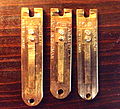
Accordions are a family of box-shaped musical instruments of the bellows-driven free reed aerophone type. The essential characteristic of the accordion is to combine in one instrument a melody section, also called the diskant, usually on the right-hand keyboard, with an accompaniment or Basso continuo functionality on the left-hand. The musician normally plays the melody on buttons or keys on the right-hand side, and the accompaniment on bass or pre-set chord buttons on the left-hand side. A person who plays the accordion is called an accordionist.
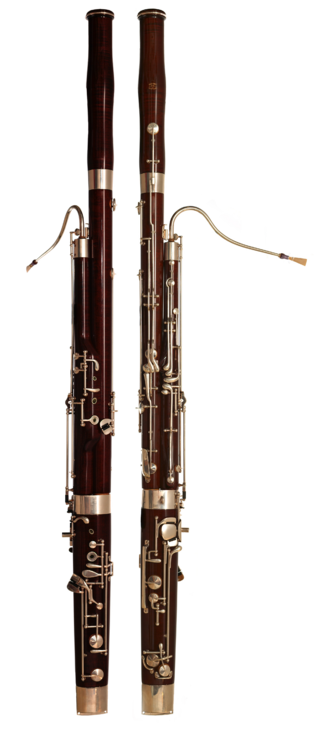
The bassoon is a musical instrument in the woodwind family, which plays in the tenor and bass ranges. It is composed of six pieces, and is usually made of wood. It is known for its distinctive tone color, wide range, versatility, and virtuosity. It is a non-transposing instrument and typically its music is written in the bass and tenor clefs, and sometimes in the treble. There are two forms of modern bassoon: the Buffet and Heckel systems. It is typically played while sitting using a seat strap, but can be played while standing if the player has a harness to hold the instrument. Sound is produced by rolling both lips over the reed and blowing direct air pressure to cause the reed to vibrate. Its fingering system can be quite complex when compared to those of other instruments. Appearing in its modern form in the 19th century, the bassoon figures prominently in orchestral, concert band, and chamber music literature, and is occasionally heard in pop, rock, and jazz settings as well. One who plays a bassoon is called a bassoonist.
The clarinet is a single-reed musical instrument in the woodwind family, with a nearly cylindrical bore and a flared bell.
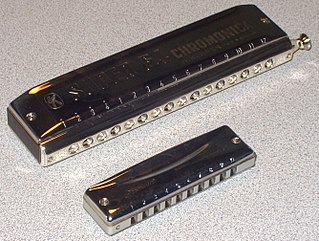
The harmonica, also known as a French harp or mouth organ, is a free reed wind instrument used worldwide in many musical genres, notably in blues, American folk music, classical music, jazz, country, and rock. The many types of harmonica include diatonic, chromatic, tremolo, octave, orchestral, and bass versions. A harmonica is played by using the mouth to direct air into or out of one holes along a mouthpiece. Behind each hole is a chamber containing at least one reed. The most common is the diatonic Richter-tuned with ten air passages and twenty reeds, often called the blues harp. A harmonica reed is a flat, elongated spring typically made of brass, stainless steel, or bronze, which is secured at one end over a slot that serves as an airway. When the free end is made to vibrate by the player's air, it alternately blocks and unblocks the airway to produce sound.

Woodwind instruments are a family of musical instruments within the greater category of wind instruments.

The uilleann pipes, also known as Union pipes and sometimes called Irish pipes, are the characteristic national bagpipe of Ireland. Their current name is a partial translation of the Irish language terms píobaí uilleann, from their method of inflation. There is no historical record of the name or use of the term uilleann pipes before the 20th century. It was an invention of Grattan Flood and the name stuck. People mistook the term 'union' to refer to the 1800 Act of Union; however, this is incorrect as Breandán Breathnach points out that a poem published in 1796 uses the term 'union'.

A pitch pipe is a small device used to provide a pitch reference for musicians. Although it may be described as a musical instrument, it is not typically used to play music as such.

The sheng is a Chinese mouth-blown polyphonic free reed instrument consisting of vertical pipes.

A free reed aerophone is a musical instrument that produces sound as air flows past a vibrating reed in a frame. Air pressure is typically generated by breath or with a bellows. In the Hornbostel–Sachs system, it is number: 412.13. Free reed instruments are contrasted with non-free or enclosed reed instruments, where the timbre is fully or partially dependent on the shape of the instrument body, Hornbostel–Sachs number: 42.

An organ stop is a component of a pipe organ that admits pressurized air to a set of organ pipes. Its name comes from the fact that stops can be used selectively by the organist; each can be "on", or "off".

Hohner Musikinstrumente GmbH & Co. KG is a German manufacturer of musical instruments, founded in 1857 by Matthias Hohner (1833–1902). It is a subsidiary of Matth. Hohner AG. The roots of the Hohner firm are in Trossingen, Baden-Württemberg. Hohner has manufactured a wide range of instruments, such as harmonicas, kazoos, accordions, recorder flutes, melodicas, banjos, electric, acoustic, resonator and classical guitars, basses, mandolins and ukuleles. Hohner is known mostly for its harmonicas.

The pump organ or reed organ is a type of organ using free-reeds that generates sound as air flows past the free-reeds, the vibrating pieces of thin metal in a frame. Specific types of pump organs include the harmonium using pressure system, suction reed organ using vacuum system, and the Indian harmonium; the historical types include the Kunstharmonium and the American reed organ; the earliest types include the physharmonica and the seraphine. The idea for the free reed was derived from the Chinese sheng through Russia after 1750, and the first Western free-reed instrument was made in 1780 in Denmark.

The Flutina is an early precursor to the diatonic button accordion, having one or two rows of treble buttons, which are configured to have the tonic of the scale, on the "draw" of the bellows. There is usually no bass keyboard: the left hand operates an air valve. A rocker switch, called a "bascule d'harmonie" is in the front of the keyboard. When this switch is thumb activated, it would open up a pallet (a pad that covers a tone hole, at the other end of the key button, for a simple Tonic/Dominant drone: Tonic on the draw and Dominant on the press, e.g. Tonic notes C/g, and Dominant G/d, without any major or minor thirds.

The musical instrument known as the regal or regalle is a small portable organ, furnished with beating reeds and having two bellows. The instrument enjoyed its greatest popularity during the Renaissance. The name "regal" was also sometimes given to the reed stops of a pipe organ, and more especially to the vox humana stop.
The guan is a Chinese double reed wind instrument. The northern Chinese version is called guanzi or bili and the Cantonese version is called houguan. It is classified as a bamboo instrument in the Ba Yin system. Unlike other instruments in the double-reed family of woodwinds which mostly have conical bores, such as the Chinese suona or the Western oboe, the guan has a cylindrical bore, giving its distinctive mellow, yet piercing buzz-like timbre.
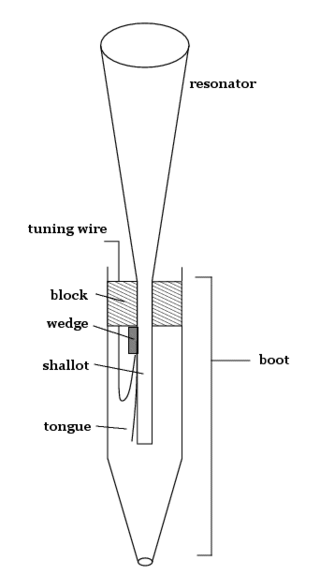
A reed pipe is an organ pipe that is sounded by a vibrating brass strip known as a reed. Air under pressure is directed towards the reed, which vibrates at a specific pitch. This is in contrast to flue pipes, which contain no moving parts and produce sound solely through the vibration of air molecules. Reed pipes are common components of pipe organs.

A tremolo harmonica is a type of diatonic harmonica, distinct by having two reeds per note. In a tremolo harmonica, the two reeds are tuned slightly off a reference pitch, one slightly sharp and the other slightly flat. This gives a unique wavering or warbling sound created by the two reeds being not exactly in tune with each other and difference in their subsequent waveforms acting against one another. The degree of beating can be varied depending on the desired effect. Instruments where the beating is faster due to the reeds being farther apart from the reference pitch are called "wet", whereas those where the beating is slower and less noticeable due to the reeds being more closely in tune are called "dry".
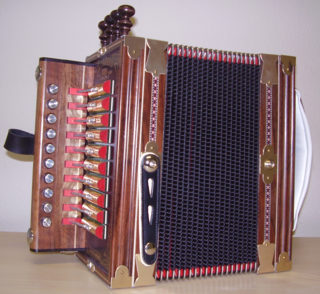
A Cajun accordion, also known as a squeezebox, is single-row diatonic button accordion used for playing Cajun and Creole music.
The aeolodion or aeolodicon is an obsolete keyed wind instrument resembling the harmonium, its tone being produced from steel springs. It had a range of six octaves, and its tone was similar to that of the harmonium. After its invention around 1800, several modifications were made, including the aeolsklavier, aeolomelodicon or choraleon, and aeolopantalon, but all versions had largely disappeared by mid-century.

The Indian harmonium,hand harmonium,samvadini, peti ("box"), or vaja, often just called a harmonium, is a small and portable hand-pumped reed organ which is very popular in the Indian subcontinent. The sound resembles an accordion or other bellows driven free-reed aerophones.

